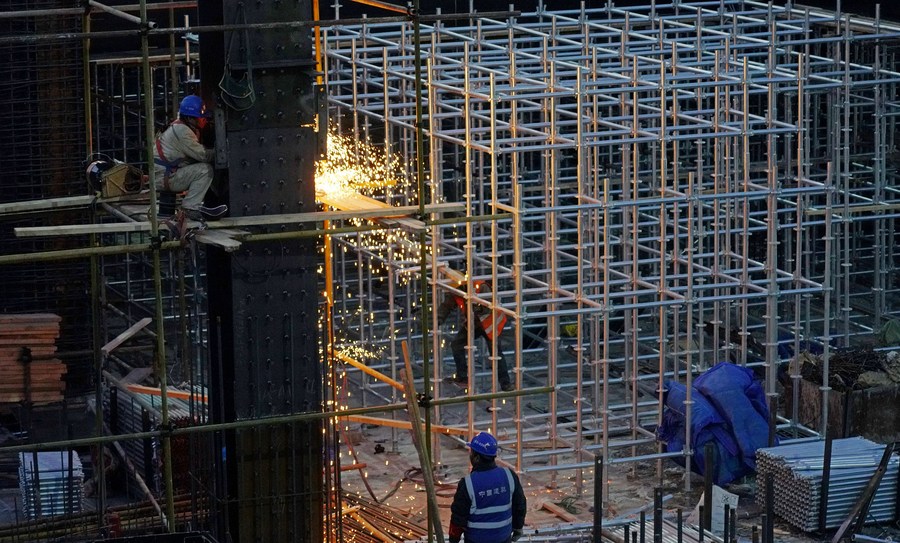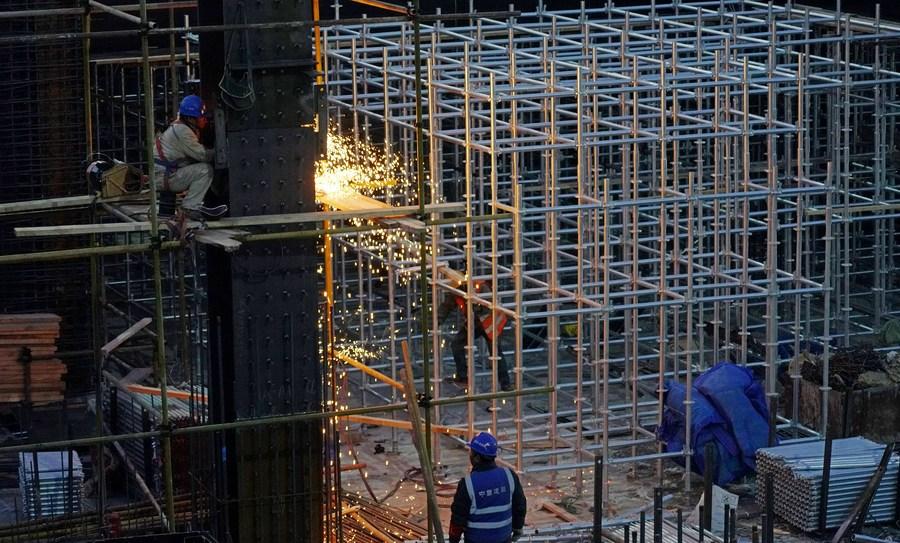
Workers weld steel columns at the construction site of the China Eastern Airlines base project undertaken by China Construction Third Engineering Bureau Co., Ltd. at the Beijing Daxing International Airport in Beijing, Dec. 17, 2020. (Xinhua/Cai Yang)
BEIJING, May 20 (Xinhua) -- Forging ahead toward a greener future, China is ever more committed to transforming the steel industry into a low carbon-emitting one amid its long-term green pledges.
As China has promised to peak carbon dioxide emissions by 2030 and achieve carbon neutrality by 2060, the steel industry remains the largest emitter among all manufacturing sectors in China, accounting for about 15 percent of the annual domestic carbon footprint.
This industry, therefore, plays a crucial role in helping the country live up to its carbon-cutting pledges.
But its green shift is far from effortless. The latest data showed that China's crude steel output rose by 15.6 percent, year on year, to 271 million tonnes in the first quarter of this year, putting a burden on this carbon-cutting undertaking.
Under the circumstance, the country has vowed further efforts to reduce crude steel output to ensure it falls yearly in 2021. Measures have also been tailored to encourage endeavors nationwide in this regard.
One of the latest moves came on May 1, when China applied a provisional zero import tax rate on pig iron, crude steel, recycled steel raw materials, and ferrochrome.
According to a circular issued by the Customs Tariff Commission of the State Council, the adjustment is expected to reduce import costs, expand steel imports, support domestic producers to cut crude steel output, and guide the industry to cut energy consumption.
Also, export tariffs on ferrosilicon, ferrochrome, and high-purity pig iron would be raised to 25 percent, 20 percent, and 15 percent, respectively.
The export policy adjustment is necessary because there is no reason to continue exporting numerous ordinary products given China's highly limited resources, said He Wenbo, stressing domestic supply. He is the executive director of the China Iron and Steel Industry Association (CISA).
Apart from tightened control over steel production, the country is stepping up efforts to carry out structural adjustments, shut down outdated production facilities, and improve energy utilization rates, the CISA said.
China's steelmakers have taken actions. A case in point is China Baowu Steel Group Corporation Limited, the world's largest steel conglomerate. In January, it announced its aim to have carbon dioxide emissions peak before 2023, reduce carbon dioxide emissions by 30 percent before 2035, and achieve carbon neutrality before 2050.
To support green development, policymakers have also urged the industry to upgrade its industrial structure and production modes.
According to the 14th Five-Year Plan (2021-2025), the country will further optimize its raw material sector structures involving petrochemical, steel, and non-ferrous metals and construction materials. Efforts will also speed up the green transformation of such sectors.
For this purpose, the steel industry should stick to a green, low-carbon path for development, and keep improving raw materials, technologies, and energy structures, said Huang Dao, an official with the CISA.
"Efforts must be made to break the bottlenecks of low-carbon technologies and promote the use of non-fossil energies in the steel industry, particularly hydrogen energy," Huang said.
Downstream companies should also be encouraged to use upgraded steel products that are more durable and recyclable, Huang said, calling for more steel structure buildings in urban areas. Enditem




 A single purchase
A single purchase









